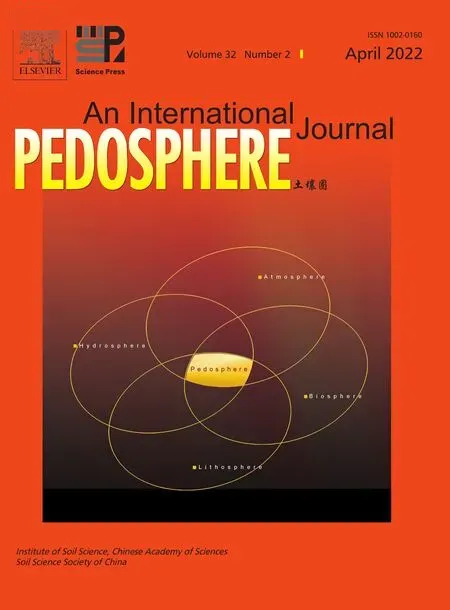Evaluation of immobilizing agents as soil quality conditioners in addition to their metal(loid)immobilizing effect
2022-05-11ChawSuLWINMinaLEEYoungNamKIMGaryOWENSandKwonRaeKIM
Chaw Su LWIN,Mina LEE,Young-Nam KIM,Gary OWENS and Kwon-Rae KIM
1 Department of Soil and Water Science,Yezin Agricultural University,Yezin,Naypyitaw 15013(Myanmar)
2 Department of Smar t-Agro Industr y,Gyeongsang National University,Jinju 52725(Korea)
3 Institute of Agriculture and Life Science(IALS),Gyeongsang National University,Jinju 52828(Korea)
4 Environmental Contaminants Group,Future Industries Institute,University of South Australian,Mawson Lakes SA 5095(Australia)
ABSTRACT In trace metal(TM)-contaminated agricultural soils,management of TM availability is important for safe crop production.In addition,maintenance or improvement of soil quality is vital for sustainable crop cultivation.Decreased TM phytoavailability and increased soil quality can be achieved by the application of various immobilizing agents to soil,which can supply both macronutrients and organic matter.This study investigated the long-term influences of four common immobilizing agents on soil biogeochemical properties and the phytoavailability of TMs in mixed metal-contaminated soil from a cultivated upland near an abandoned mining site.Lime(L),gypsum(G),fly ash(F),and animal manure-based compost(C)were applied to pots containing contaminated soil,either individually or in combination.After incubation for three years under sequential cultivation of two crops and fallow,soil biogeochemical properties were determined,and Brassica rapa plant bioassay was performed.The phytoavailability of all TMs(both cationic metals and anionic metalloids)remained significantly lower in soils treated with immobilizing agents even after three years,when compared with the no-agent control(CK)soil.In addition,the soil quality was significantly improved by treatment with immobilizing agents.For instance,the C and L+C treatments were the most effective in improving soil physical(bulk density,porosity,and water-resistant aggregate stability),chemical(pH,organic matter,total nitrogen,cation exchange capacity,and plant-available phosphorus,magnesium,and potassium),and biological(microbial biomass carbon and dehydrogenase activity)properties.The improvement of soil properties and lowering of TM bioavailability were also consistent with the most significant increase in B.rapa biomass production observed in the C treatment,followed by the L+C,G+F,L,G,F,and L+G treatments,as compared with that in CK.These results indicate that the function of the TM-immobilizing agent as a soil quality conditioner,in addition to its TMimmobilizing effect,should be considered when selecting such agents for agricultural or ecological applications.
Key Words: crop production,metal bioavailability,metal immobilization,metal phytoavailability,soil amendments,soil biogeochemical properties,soil remediation,trace metals
INTRODUCTION
Soil contamination by trace metal(TM)poses potential risks to humans,directly through ingestion and indirectly through contact with contaminated soils,the food chain(soilplant-human or soil-plant-animal-human),and consumption of contaminated groundwater(McLaughlinet al.,2000a).Soil contamination by toxic TMs also threatens food safety and decreases land usability for agricultural production(McLaughlinet al.,2000b;Linget al.,2007).In addition,TMs affect the soil’s ability to perform its key functions by disturbing both soil biological and chemical properties.Soils contaminated by TMs generally exhibit extreme pH,poor structure,low fertility,and low microbial activity(Lwinet al.,2018),which consequently decrease crop production(Zhanget al.,2014).Therefore,soil remediation techniques are required for sustainable crop production,not only to reduce soil total metal concentrations and bioavailable metal fractions,but also to improve soil quality.
Recently,in situimmobilization techniques for soil remediation have become popular because of their low cost,simplicity,and ease of application.Immobilizationviasimple application of soil amendments can decrease TMavailability,thus retarding any TM-induced adverse effects on living organisms(van Herwijnenet al.,2007).Soil amendments can reduce metal availability and toxicity by altering the bioavailable fractions to more geochemically stable phases,through a combination of adsorption,complexation,and precipitation(Hashimotoet al.,2009).Moreover,recent studies have shown that the use ofin situimmobilization techniques can improve the quality of TM-contaminated soils because the soil amendments most commonly used as immobilizing agents are also sources of various essential nutrients and can improve soil physiochemical properties(Chiuet al.,2006).Thus,incorporation of such amendments can help restore the ecological function of TM-contaminated sites in the long term(Bastaet al.,2001;Geebelenet al.,2002;Brownet al.,2003).For effective remediation,the extent of soil quality improvement should also be considered when selecting the immobilizing agent to be applied.
Although soil biogeochemical properties can be measured as indicators of soil quality,they are sensitive to management and environmental conditions.Several studies support that in addition to TM immobilizers,soil amendments can be crucial mediators for improving the characteristics of contaminated soils when soil conditions are initially unfavorable for typical soil biota(e.g.,acidic pH,low fertility,and poor structure)(Alvarengaet al.,2009;Pardoet al.,2014;Lwinet al.,2018;Wanget al.,2018).For instance,organic amendments,such as biochar,compost,and manure,can enhance soil physical properties by increasing soil porosity,aggregate stability,and water-holding capacity and decreasing soil bulk density(Al Mamunet al.,2017).Additionally,such organic amendments can improve soil chemical(e.g.,pH,organic matter(OM),cation exchange capacity(CEC),and nutrient cycling and release)and biological(e.g.,microbial biomass and activity)properties and plant growth(Kargaret al.,2015;Lwinet al.,2018).Inorganic soil additives,such as lime and gypsum,are also known to directly ameliorate soil acidity(Udeigweet al.,2011)and indirectly increase plant nutrient availability(Haynes and Naidu,1998),calcium(Ca)-induced aggregation(Chan and Heenan,1998;Chen and Dick,2011),and biological activity by facilitating favorable environments for soil biota(e.g.,earthworms)(Springett and Syers,1984).Moreover,application of industrial wastes,such as fly ash,is beneficial in improving the biogeochemical properties of TM-contaminated soils(Ghodratiet al.,1995;Sarangiet al.,2001;Jala and Goyal,2006;Ramet al.,2007).Thus,various immobilizing agents,applied either individually or in combination,can contribute to the improvement of soil quality indicators.
Previous studies involving immobilizing agents have focused mainly on their TM-immobilizing efficiency,without considering their impacts on soil quality.Furthermore,studies that took their impacts on soil quality into consideration were generally short term,reporting outcomes from a short period of laboratory controlled incubation or one cycle of the growing season.The efficacy and chemistry of immobilizing agents can change over time due to the variability and complexity of the soil matrix.Therefore,long-term assessment of soil quality and metal availability after application of soil amendments is of great importance not only for assessment of the efficacy of soil amendments,but also for understanding the environmental implications associated with the use of such amendments.Thus,the main objectives of this study were to assess the improvement of soil properties after application of metal-immobilizing agents over a three-year pot incubation period and to investigate if the immobilizing efficacy persisted for a prolonged period.
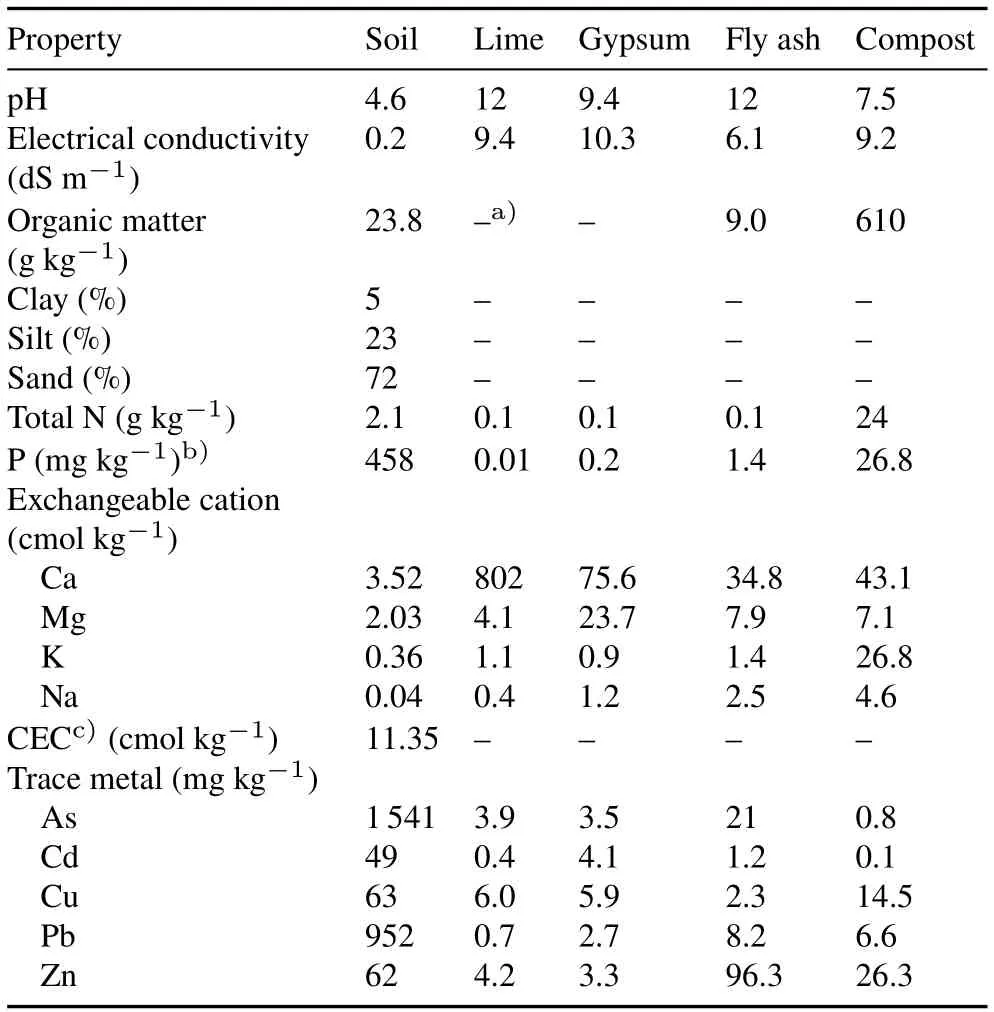
TABLE I Selected properties of the mixed metal-contaminated soil from a cultivated upland near an abandoned mining site and trace metal-immobilizing agents(lime,gypsum,fly ash,and animal manure-based compost)used in the present study
MATERIALS AND METHODS
Soil and immobilizing agents
The soil used in this experiment was sampled from a cultivated upland near an abandoned mining site in Gongju,Korea.Topsoil(0—25 cm)was collected and mixed homogeneously prior to pot incubation.The soil texture was sandy loam,and soil concentrations of arsenic(As),cadmium(Cd),and lead(Pb)(Table I)were high,greatly exceeding the local environmental guideline values outlined in the Soil Environmental Conservation Act 2010(Ministry of Environment,Korea)of 25 mg kg-1for As,4 mg kg-1for Cd,200 mg kg-1for Pb,150 mg kg-1for Cu,and 300 mg kg-1for Zn.
Four different immobilizing agents,including lime,gypsum,fly ash,and animal manure-based compost,were used(Table I).Lime was selected as a pH-inducing agent to reduce the acidity of the metal-contaminated soil(Kimet al.,2016).Gypsum was selected as a dissolved organic carbon(DOC)coagulator;DOC is known to increase metal bioavailability by forming dissolved organo-metallic complexes(Grayet al.,2006),and reduction in the DOC concentration of the soil solution following application of Ca-containing compounds,such as gypsum,can decrease the phytoavailable TMconcentrations(Kimet al.,2018).The Ca-containing agents,including lime and gypsum,can trigger soil aggregation.It was expected that soil physical properties would be improved by the application of Ca-containing agents.Fly ash was selected as a multi-functional material to increase both soil pH and surface adsorption of TMs(Kimet al.,2015)and lower soil bulk density due to its high porosity(Keneet al.,1991).Finally,animal manure-based compost,which is widely used as a traditional soil conditioner,was included as an organic metal sorption agent(Kimet al.,2016).For use in the present study,commercially available phosphogypsum and compost were bought from a market,and fly ash was obtained from a local thermoelectric power plant.The residual TMconcentrations of the applied immobilizing agents(Table I)were well below the Korean guidelines for soil amendments outlined in the Fertilizer Control Act 2015(Ministry of Agriculture,Food and Rural Affair,Korea).
Soil incubation experiment
In total,24 pots(43 cm in height,30 cm in diameter)were filled with 25 kg of metal-contaminated soil(dry weight basis).The TM-immobilizing agents were then applied to each pot,both individually and in combination,totaling 7 treatments(i.e.,lime(L),gypsum(G),fly ash(F),compost(C),lime+gypsum(LG),lime+compost(LC),and gypsum+fly ash(GF)),with a no-agent control(CK)(Table II).Lime(250 g on a dry weight basis)was applied at 1%to achieve the target pH of 7.5—8.0,whereas other amendments(each 750 g on a dry weight basis)were applied at 3%.All treatments were triplicated.All pots were buried in a cultivated upland,leveled with the ground surface,and were cultivated with two crop species over three years.Balloon flower(Platycodongrandiflorus)and barley(Hordeum vulgare)were grown for six months followed by a six-month fallow period in the first and second years,respectively,which was followed by fallow for one year.During the fallow period,all emerging weeds were removed,and the soil moisture content was maintained by natural rainfall and occasional drip irrigation using a pin dropping irrigation system.
Soil analysis
Soil samples were collected from the pots using a core sampler(100 cm-3),to determine the physical properties after the three-year incubation experiment.Before soil sampling,the pots were removed from the surrounding soil,inverted on to a plastic plate and then gently lifted up to release the soil.One side of the soil mass was then gently cut to obtain a flat face,and an intact core sample was collected from this face at a depth of around 10 cm from the original soil surface.The core was sealed tightly using double-sided lids and transported to the laboratory for further analyses.Soil bulk density and porosity were measured from the weight of the core soil after oven-drying at 105°C.Total porosity was calculated using the following equation based on the measured bulk density and assuming a soil particle density of 2.65 g cm-3,the general particle density value accepted for Korean soils:


TABLE II Amounts of immobilizing agents applied to 25 kg mixed metal-contaminated soil from a cultivated upland near an abandoned mining site in each pot for incubation
whereρbis the bulk density andρpis the particle density.After core sampling,the remaining soil mass was broken and mixed thoroughly,and approximately 1 kg of the soil was subsampled to determine the physicochemical properties.These soil samples were air dried,sieved to pass through a 2-mm sieve,and stored in a plastic zip-lock bag until further analysis.The soil pH and electrical conductivity were determined from a 1:5 soil:water suspension using a pH meter(MP220,Mettler Toledo,Switzerland)and an EC meter(MC226,Mettler Toledo,Switzerland),respectively,after shaking for 1 h.Soil DOC was analyzed in a 1:5 soil:water suspension using a total organic carbon analyzer(2100S,Analytik Jena,Germany),after shaking for 1 h and filtering through 0.45-μm glass fiber filters.The water-resistant aggregate ratio was determined using a wet sieving apparatus(M1.08.13.E,Eijkelkamp,The Netherlands).Available P was extracted by the Bray-No.1 method and determined colorimetrically using a UV spectrophotometer(SPECORD 200 plus,Analytikjena,Germany).Total N was measured using a C/N AutoAnalyzer(TruMAC,LECO,USA).Soil OM content was determined by the Walkley-Black method(Walkley and Black,1934).Soil CEC and exchangeable cations including Ca,potassium(K),magnesium(Mg),and sodium(Na)were determined using the 1-mol L-1ammonium acetate(NH4OAC)extraction method at pH 7 and analyzed using atomic absorption spectroscopy(AAS)(GFA-7000 A,Shimadzu,Japan).For evaluating soil TMconcentrations,2 g of soil was digested using 9 mLaqua regia,a 1:3 mixture of nitric acid and hydrochloric acid,with a block digester(OD-98-001,ODLAB,Korea).The TMconcentration in the digested solution was measured using inductively coupled plasma optical emission spectrometry(ICP-OES)(8300DV,Perkin Elmer,USA).Certified reference materials(2711a Montana soil)and blanks were also included in the digestion for quality assurance.The recovery values for As,Cd,Cu,Pb,and zinc(Zn)in the reference materials(n=5)were 92%±2%,95%±0.4%,93%±6%,92%±11%,and 90%±9%,respectively.
Soil dehydrogenase activity(DHA)and microbial biomass carbon(MBC)were determined in fresh(non-dried)soil samples collected from each pot at the time of soil sampling following the method of Casidaet al.(1964)and the chloroform fumigation direct extraction method(Brookeset al.,1985;Becket al.,1997),respectively.
Plant bioassay experiment
After sub-sampling soil from pots for soil property analyses,the remaining soil was repacked into the original pots for a plant growth experiment.The plant bioassay was conducted to evaluate plant growth performance and changes in the TM-immobilizing effect over time by determining TMaccumulation in plant tissues post immobilizing agent amendment.Two-week-old nursery seedlings ofBrassica rapawere planted in the pots(one plant per pot)and allowed to grow for one month.The aboveground plant tissues were then harvested by cutting at the soil surface,washed thoroughly with tap water to remove any attached particles,and then rinsed thrice with distilled water.The samples were oven dried at 70°C until a constant weight was obtained,and the dry weight of each plant sample was then measured.The TM concentrations were determined using ICP-OES following digestion of the plant tissue samples with concentrated HNO3in a block digester(OD-98-001,ODLAB,Korea).Spinach leaves(standard reference material 1570a)and blanks were included in each batch to validate the analyzing procedure.The recovery values for As,Cd,Cu,Pb,and Zn in the reference materials(n=5)were 110%±12%,94%±0.8%,93%±4%,92%±11%,and 90%±6%,respectively.
Statistical analysis
Data were presented as mean±standard deviation of the triplicates.Differences between the treatments were determined by one-way analysis of variance(ANOVA)and least significant difference(LSD)test in IBMSPSS Statistics 20(IBM,USA).Differences were considered significant atP<0.05.
RESULTS AND DISCUSSION
Variations in TM phytoavailability
It was observed that all immobilizing agents were effective for at least three years,as evidenced by the significantly lower(P<0.05)concentrations of As,Cd,Cu,Pb,and Zn in the leaves ofB.rapaplants grown in the treatments with immobilizing agent(s)when compared with those in CK(Fig.1).In particular,gypsum,as a DOC coagulator,was the most effective in metalloid(As)immobilization,whereas lime and fly ash,as pH change-inducing agents,and compost,as a TMsorption agent,were relatively more effective in immobilizing cationic metals(Cd,Cu,Pb,and Zn).In the treatment with gypsum alone,the accumulated leaf As concentration were 77%lower in comparison with that in CK.The treatment with lime alone decreased leaf Cu and Zn by 52%and 74%,respectively,whereas the treatment with compost alone decreased leaf Cd and Pb contents by 61%and 60%,respectively.
A decline in As phytoavailability following gypsum incorporation in soil has previously been reported by Kimet al.(2018).As gypsum is a Ca-rich compound without any liming effects,it decreases As phytoavailability through DOC-As coagulation in soil.This mitigates the usual phenomenon of increased phytoavailability of anionic elements such as As,which occurs when soil pH increases due to the addition of Ca-rich compounds,such as lime(Joneset al.,1997;Mahimairajaet al.,2005).The coagulation of DOC by gypsum also decreased the concentration of phytoavailable cationic metals(Fig.1),which may be attributed to the coagulation of DOC with cationic metals in soil.The DOC concentration decreased the most when gypsum was added individually or in combination with lime(Table III).
It is known that an increase in soil pH induces metal immobilization through several processes,including precipitation of metals as insoluble oxides,hydroxides,carbonates,and phosphates(Lindsay,1979).In soils treated with alkaline materials,increased precipitation and sorption are identified as the main mechanisms involved in the retention of metals(Lombiet al.,2003;Leeet al.,2009).In the present study,lime applied individually or in combination with other agent increased soil pH by around 2 units,and compost applied individually,as a sorption material,increased soil pH by approximately 1 unit(Table III).Ross(1994)and Walkeret al.(2004)reported that compost application to soil increased Cu,Pb,and Zn immobilization in the soil solution,which was attributed to increased pH and humification of OM.Soil OM can alter the availability of metals by converting them to immobile forms bound to OM,oxides,or carbonates(Walkeret al.,2004).In addition,Misra and Pande(1974)reported that production of humic substances,organic acids,and amino acids during OMdecomposition can alter metal availability by forming complexes with metals.
In comparison to the treatments with individual immobilizing agents,combined agent treatments were more likely to be effective due to simultaneous additive decreases in the phytoavailability of metal and metalloid soil pools(Fig.1).The combined treatments,LG,LC,and GF,were relatively more effective in decreasing all examined metal(loid)s in the leaf tissues ofB.rapaplants,when compared with their corresponding individual treatments.Kimet al.(2016)previously reported that application of lime in combination with other amendments(compost and gypsum)resulted in a greater decrease in the Cd and Pb concentrations inAngelicaandAtractylodesrhizomes than application of lime alone.This can be attributed to the additive effect of each agent.For example,increases in binding sites and pHdue to application of compost and lime,respectively,induce deprotonation from the binding sites,thus enhancing metal sorption capacity.In addition,application of sorption agents can enhance the effect of immobilizing agents that induce pH changesviaan increase in the pH-dependent charge(Kimet al.,2016).Decrease in metal(loid)phytoavailability achieved byin situimmobilization can help secure crop food safety and mitigate metal(loid)toxicity.However,application of immobilizing agents as a part of treatment for improving the overall quality of metal(loid)-contaminated soils needs to be assessed(Bastaet al.,2001),as these soils are required to perform their fundamental agricultural and ecological functions.
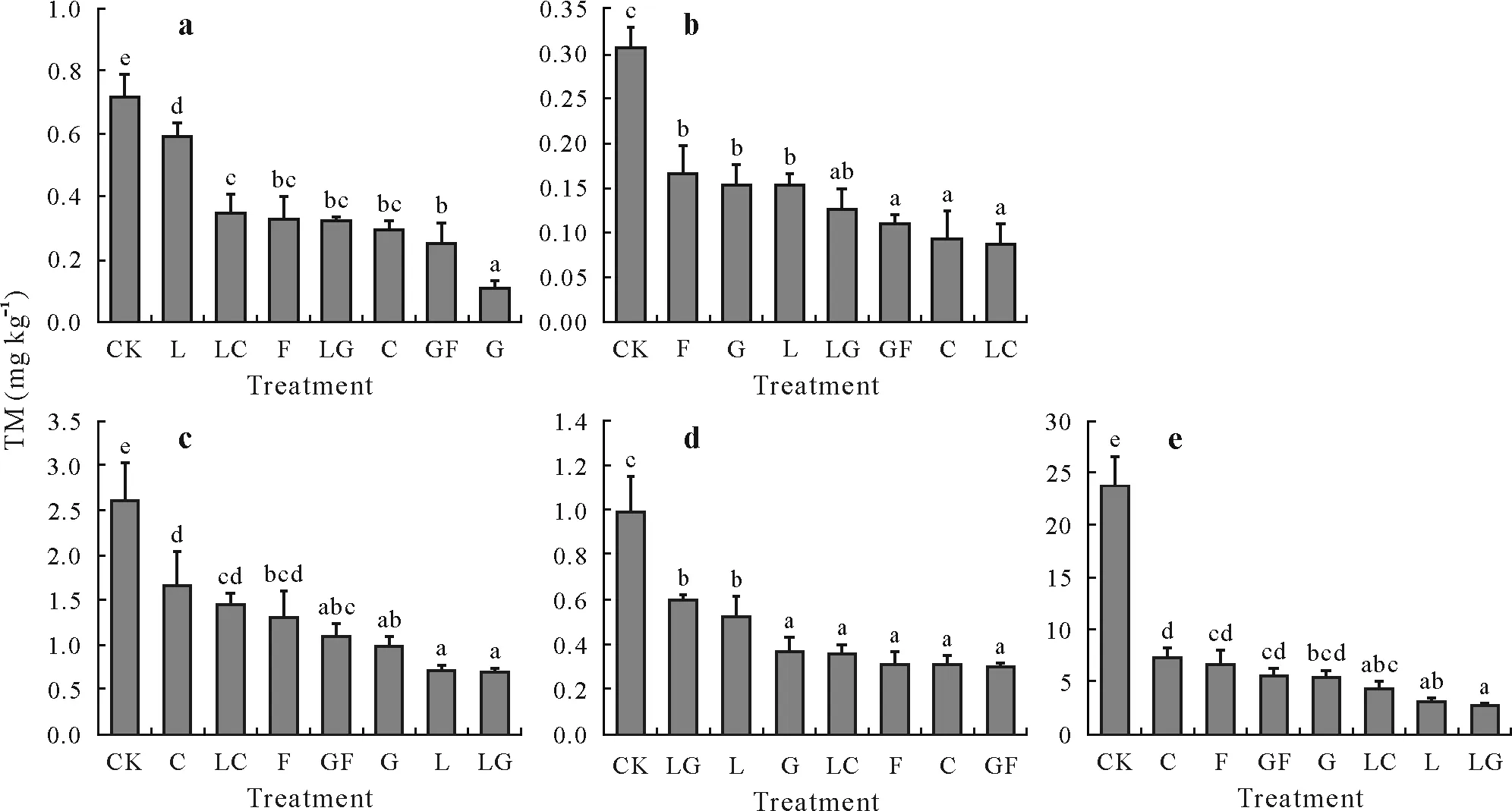
Fig.1 Effects of different immobilizing agent(lime,gypsum,fly ash,and animal manure-based compost)treatments on As(a),Cd(b),Cu(c),Pb(d),and Zn(d)concentrations in leaves of Brassica rapa plants grown on mixed metal-contaminated soil from a cultivated upland near an abandoned mining site.Values are means with standard deviations shown by vertical bars(n=3).Bars with different letters indicate significant differences(least significant difference(LSD)test,P<0.05).See Table II for details of the treatments.TM=trace metal.
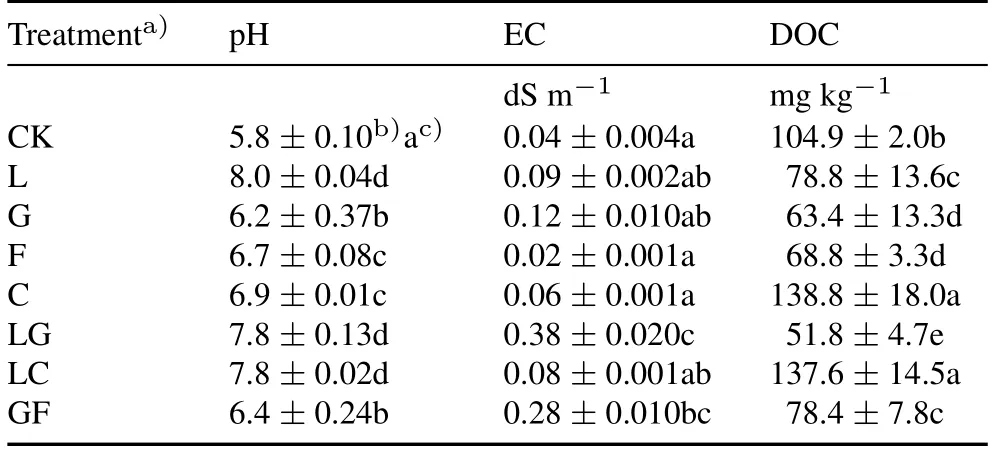
TABLE III Differences in the levels of pH,electrical conductivity(EC),and dissolved organic C(DOC)of mixed metal-contaminated soil from a cultivated upland near an abandoned mining site with treatments of different immobilizing agents(lime,gypsum,fly ash,and animal manure-based compost)
Effects of immobilizing agents on soil quality
All immobilizing agents used in this study for controlling TMavailability have successfully been used in agricultural soils as either soil conditioners or nutrient sources.Similarly,the results of this study also indicated a positive effect of these immobilizing agents on both biological and physicochemical soil quality parameters(Table III,Fig.2).The treatments with compost alone and in combination with lime appeared to be the most effective in improving soil chemical properties;the pH increased from the initially low value of 5.8 to high values of 6.9—7.8(Table III),which are more suitable for plant growth as plants prefer weakly acidic or neutral conditions.The growth performance of many crops is the best under neutral soil pH,and most plant nutrients are optimally available to plants in the pH range of 6.5—7.5(Jensen,2010).The treatment with compost and lime in combination yielded the greatest increase in soil OM and CEC,by around 27 g kg-1and 5 cmol kg-1,respectively(Fig.2),which was attributed to the organic substances contained in the compost.Angelovaet al.(2013)reported that compost application to contaminated soil increased soil OM,CEC,and available macronutrients,while decreasing the TMlevels in soil.

Fig.2 Effects of different immobilizing agent(lime,gypsum,fly ash,and animal manure-based compost)treatments on chemical properties of mixed metal-contaminated soil from a cultivated upland near an abandoned mining site.Values are means with standard deviations shown by vertical bars(n=3).Bars with different letters indicate significant differences(least significant difference(LSD)test,P<0.05).See Table II for details of the treatments.OM=organic matter;CEC=cation exchange capacity;TN=total N;AP=available P.
As shown in Table III,application of lime alone resulted in relatively high soil pH(>8),and the extent of increase in soil pH was impeded slightly with application of lime in combination with gypsum(pH 7.8)or compost(pH 7.8).These combination treatments obtained soil pH levels more suitable for plant growth performance and better metal(loid)immobilization efficiency than the lime application alone and thus could be recommended.
In regards to increasing the major nutrient contents in soil,the treatments with compost alone and in combination with lime yielded the highest total N concentration,as compost contained the highest amount of OM,resulting in their total Nof 42 and 37 g kg-1,respectively.No significant increase in total N was observed in the treatments with the other immobilizing agent(s)as compared with CK.Tordoffet al.(2000)recommended that N fertilizers should be routinely added during soil rehabilitation,in addition to the application of inorganic soil amendments,as N is the major nutrient for plant growth.Phosphorus also plays a vital role in virtually all plant processes involving energy transfer.Except the treatment with lime alone,all treatments increased soil available P,with the greatest increases observed in the treatments with compost(Fig.2).This was attributed not only to the introduction of P contained in the compost,but also to the near-neutral pH resulting from the compost treatments.In general,available P remains high at neutral soil pH and decreases through Fe-P and Ca-P complex precipitations under acidic and alkaline conditions,respectively(Das and Mandal,2015).Although all treatments positively affected exchangeable Ca,its concentration exhibited the highest increase in the treatments with lime alone and in combination with other agents(Fig.2).The treatment with compost alone increased exchangeable Mg and K most significantly,by 1.8 and 0.42 cmol kg-1,respectively,whereas the treatment with lime or gypsum alone resulted in relatively lower values.This phenomenon was attributed to the leaching of Mg and K from soil.In general,the large amounts of Ca supplied by lime or gypsum induce the release of Mg and K from soil particlesviacation exchange reactions,resulting in subsequent leaching of Mg and K through the soil profile over time(Shainberget al.,1989).Thus,an additional supply of Mg and K is recommended when using large amounts of gypsum as a soil conditioner for treating agricultural soils(Syed,1987).Unlike other nutrient elements,exchangeable Na decreased with the addition of all immobilizing agents when compared with CK.Soil chemical properties were the most notably improved by compost application.This was consistent with previous studies that reported improved soil chemical properties,such as pH(Ouédraogoet al.,2001),and increased plant nutrient availability and crop yield(Hartl and Erhart,2005)under compost application.
The treatments with compost alone and in combination with lime exerted the greatest effects on soil microbial properties,yielding overall higher levels of soil MBC and DHA than other treatments(Fig.3).This was attributed not only to the decreased metal(loid)toxicity through immobilization,but also to increased C and N resources provided by compost.Application of lime and gypsum in combination also improved soil biological properties by decreasing metal(loid)toxicity through immobilization(Kiikkiläet al.,2001;El-Azeemet al.,2013).However,application of fly ash alone did not improve soil biological properties although the decrease in metal(loid)availability in this treatment was comparable to that of lime or gypsum alone(Fig.1).Previous studies have reported that the addition of fly ash to sandy soils severely inhibits microbial respiration,numbers,size,and enzyme activity and soil N cycling processes,such as nitrification and N mineralization(Pichtel,1990;Garauet al.,1991).Further studies partly attributed these adverse effects of fly ash on dies partly attributed thes soil microorganisms to its high soluble salt and trace element contents(Cerevelliet al.,1986;Wong and Wong,1986;Sharma and Kalra,2006).However,this was not the case in our study,as Na and trace element contents of fly ash were not very different from those of the other agents(Table I,Fig.2).This suggests a specific component or reaction occurring in the presence of fly ash that decreases microbial activity.The nature of this reaction is not clear;however,the evident decrease in soil microbial activity is sufficient for recommending against using this agent for metal(loid)immobilization in soil.
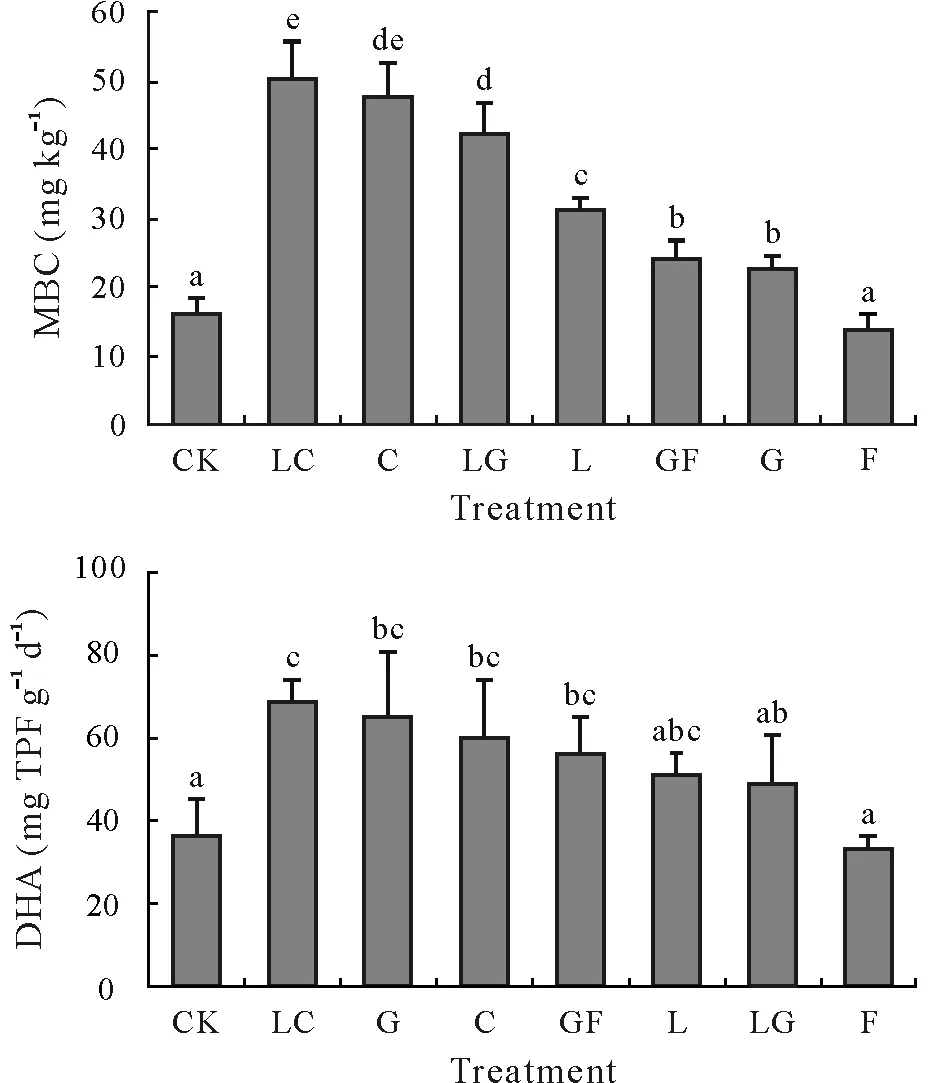
Fig.3 Effects of different immobilizing agent(lime,gypsum,fly ash,and animal manure-based compost)treatments on microbiological properties of mixed metal-contaminated soil from a cultivated upland near an abandoned mining site.Values are means with standard deviations shown by vertical bars(n=3).Bars with different letters indicate significant differences(least significant difference(LSD)test,P<0.05).See Table II for details of the treatments.MBC=microbial biomass C;DHA=dehydrogenase activity;TPF=triphenyl formazan.
The treatments with compost applied individually or in combination with lime yielded the best improvements in soil physical properties,reducing soil bulk density and increasing soil porosity and water-resistant aggregate stability(Fig.4).As previously discussed,the treatments with compost increased soil OMcontent,which played an important role in improving soil stability,structure,aeration,and aggregation,resulting in higher CEC,water-holding capacity,and chelation ability(Sparks,1995;Zink and Allen,1998).Calcium from lime and gypsum can trigger soil aggregation as Ca ions can act as binding agents(Roth and Pavan,1991)to initiate coagulation of soil particles.Thus,the treatment with lime or gypsum also improved soil physical properties although the extent of improvement was not as high as that with compost alone.Unlike the other treatments,the treatment with fly ash alone resulted in limited improvement of soil physical properties.

Fig.4 Effects of different immobilizing agent(lime,gypsum,fly ash,and animal manure-based compost)treatments on physical properties of mixed metal-contaminated soil from a cultivated upland near an abandoned mining site.Values are means with standard deviations shown by vertical bars(n=3).Bars with different letters indicate significant differences(least significant difference(LSD)test,P<0.05).See Table II for details of the treatments.BD=bulk density;WRA=water-resistant aggregates.
Plant biomass production
Decline in metal toxicity through immobilization by the agents applied individually and in combination together with the improvement of soil physicochemical properties significantly increased plant biomass(Fig.5).The greatest increase in plant biomass was obtained in the treatments with compost alone and in combination with lime,which was consistent with the results of soil quality.All other immobilizing agents applied individually or in combination significantly increased plant biomass,with slightly better results obtained with application of lime and gypsum alone than with application of fly ash alone,which was consistent with the effects of these agents on both biological and physical parameters of soil.
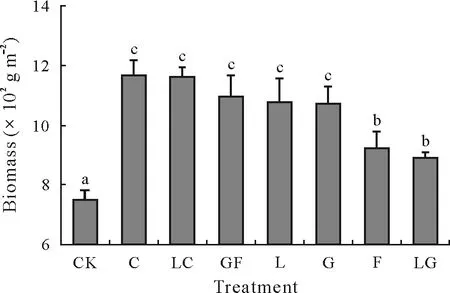
Fig.5 Effects of different immobilizing agent(lime,gypsum,fly ash,and animal manure-based compost)treatments on Brassica rapa plant biomass production on mixed metal-contaminated soil from a cultivated upland near an abandoned mining site.Values are means with standard deviations shown by vertical bars(n=3).Bars with different letters indicate significant differences(least significant difference(LSD)test,P<0.05).See Table II for details of the treatments.
CONCLUSIONS
The role of immobilizing agents in improving soil quality,in addition to their TMimmobilization efficiency,must be considered during selection for practical remediation of metal(loid)-contaminated soil.This is because proper soil function is not only influenced by metal(loid)toxicity,but also by other physicochemical and biological properties of soil.Soil quality parameters can directly influence soil productivity,as evidenced by the variation in the biomass ofB.rapaplants in response to the different treatments in this study.All four immobilizing agents(compost,lime,gypsum,and fly ash)tested in this study improved the characteristics of TM-contaminated soil and inhibited the accumulation of As,Cd,Cu,Pb,and Zn in leaves ofB.rapaplants to some extent over time.Overall,taking both TM immobilization efficiency and soil quality improvement into consideration,the preference of immobilizing agent for practical application to agricultural soil was in the order of compost>lime≈gypsum>fly ash.In addition,the treatment with lime and compost in combination was superior to the treatment with compost alone,suggesting additive effects on soil function,as evidenced by better biological parameters assessed,such as MBC and DHA.Although the results of this study clearly indicate that many common immobilizing agents can also improve soil quality over the long term,it is not known if this is true for all immobilizing agents.Future work should assess a greater number of immobilizing agents,applied individually and in combination,to determine their longterm effects on both TM immobilization and soil quality improvement.
ACKNOWLEDGEMENT
This work was supported by Gyeongsang National University Grant in 2020—2021.
杂志排行
Pedosphere的其它文章
- Ultraviolet B radiation-mediated stress ethylene emission from rice plants is regulated by 1-aminocyclopropane-1-carboxylate deaminase-producing bacteria
- Drying-rewetting rather than sieving stimulates soil respiration
- Methanotrophy-driven accumulation of organic carbon in four paddy soils of Bangladesh
- Complementary effect of zoo compost with mineral nitrogen fertilisation increases wheat yield and nutrition in a low-nutrient soil
- Comparison of potential potassium leaching associated with organic and inorganic potassium sources in different arable soils in China
- A conceptual framework and an empirical test of complementarity and facilitation with respect to phosphorous uptake by plant species mixtures
